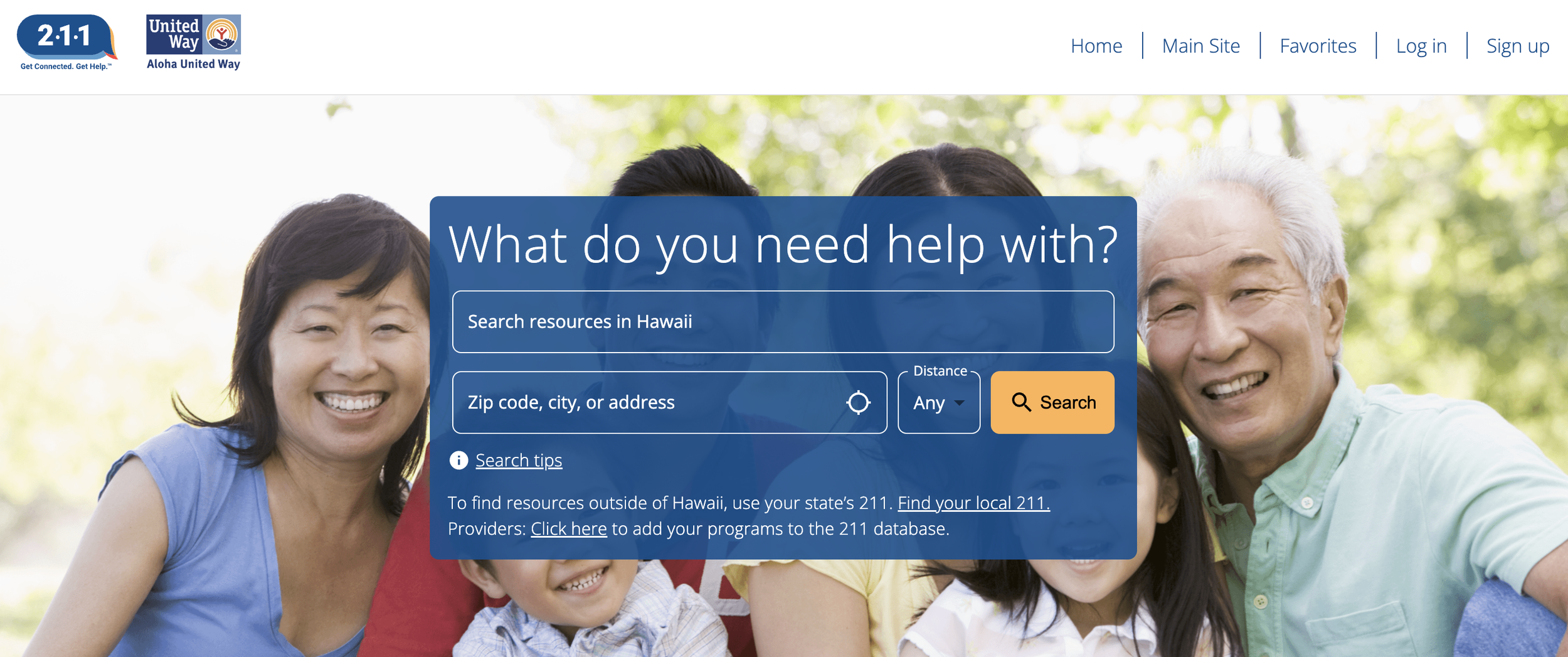Enhancing Hawai‘i’s Household Need Data Landscape: An Update to Aloha United Way’s 211 Search Engine and Dashboard
Aloha United Way (AUW) has connected Hawai‘i residents to social services through 211 since 1990 when they transitioned a paper record-based service to an electronic database of over 3,000 health and human service programs across Hawai‘i. Since then, AUW 211 has emerged as an important resource that allows community members to access social services of all kinds. By offering a call line, text, email, live chat, and online access, AUW 211 helps community members in need navigate a service provider landscape that may offer a lot of assistance but can be difficult for many to access on their own.
AUW 211 became especially relevant with the arrival of COVID and the subsequent economic stresses resulting from mitigation measures. A spike in inquiry volume during this time significantly stressed their system, catalyzing a partnership between AUW and Hawai‘i Data Collaborative (HDC) to modernize and stabilize the 211 platform, enabling 211 to handle increased call loads as well as capture and utilize much more inquiry-related data.
AUW and HDC’s shared interest in 211 data analytics stems from the fact that AUW 211 sits at the intersection of those who need assistance and those who provide it. While still protecting the privacy of individuals seeking assistance, 211 can provide a valuable window into the state of our communities because each 211 interaction provides rich, timely data about expressed needs and the resources available (or not) to meet that need. To maximize this data’s usefulness, HDC developed and launched a public-facing dashboard in 2021. At launch, the dashboard only included call, text, live chat, and email data. Recently, HDC and AUW did another update to the system that involved overhauling the online public-facing database to include new enhanced search engine functionality as well as the ability to capture aggregated and anonymized user analytics from the new AUW 211 online search engine.
This was an important upgrade because individuals today are as likely, if not more likely, to seek help through online sources. By capturing this online search data, the 211 data set now reflects all the inquiries that were previously being missed. Along with updating the 211 system, HDC has also updated the original 211 dashboard to offer a fuller picture of household need by including data across all possible 211 access methods, including web searches.
AUW 211 Online Search Portal vs. AUW 211 Dashboard
While the AUW 211 online search portal is geared towards community members looking for social service resources, HDC’s AUW 211 dashboard is intended for service providers, policymakers, and funders looking to better understand Hawai‘i’s household need landscape. Both provide valuable information to their intended audiences when it comes to household need. And, by capturing and presenting data from all 211 inquiry streams, 211 not only provides value to community members, but it also offers the most accurate and timely snapshot when it comes to understanding how households in Hawai‘i are faring and what kinds of services they’re seeking. Our hope is that this data will be used to inform policy, program design, and resource allocation to better address household need.
211 Dashboard Original Functionality
Much of the dashboard will be familiar to those who have used the 211 dashboard in the past. The original view remains unchanged aside from a style refresh, with the most significant change being the addition of the “View Web Search Data” button added to the top right of the dashboard’s main view.
When users open the dashboard, they will be able to view the legacy data and specify the date range and filter the data by region. This resource request data coming in from calls, texts, and live chats will display based on prevalence, and from there may be broken down by primary category and subcategory, as well as by gender and age group. When a primary category is selected, the Weekly Requests Over Time section displays a chart comparison between total requests and requests for the selected category, while the bottom section displays a map of requests for the same category by zip code, as well as a list of the top zip codes with the highest rates of requests.
Added 211 Dashboard Functionality: Search Engine Data View
The updated dashboard now contains a second view to access the online search engine data, which users can navigate to using the “View Web Search Data” button in the top right corner of the original view. On this tab, users may view:
Total number of web searches by county;
Ten most common search terms; and
Ten most commonly browsed resources on AUW 211’s online search engine.
You can also use the date slider to adjust the start and end date and filter the data for a specific date range, but please note that the first start date available is March 27, 2024, which is when this data first started being captured.
Web Search Data Insights and Limitations
Although the web search data is relatively new, it already appears to correlate with the legacy data pulled from 211 calls, texts, and chats, confirming the information provided from the legacy data. Food, housing, utility, and rent assistance are the top requests across all 211 inquiry streams, showing that many in our communities still struggle to meet their most basic needs.
The web search data does, however, have its limitations. One significant limitation is that the county from which over 60% of the web search data comes from is unknown due to the fact that AUW 211 prioritizes anonymity and protecting the identities of the individuals who search for services. Without reliable geographic specificity, the data cannot provide insights or recommendations for resource need in specific communities. Still, we believe this additional web search data provides a more complete picture of requests, and by extension need in Hawai‘i.




